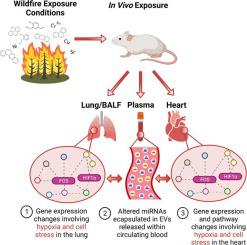Environment International ( IF 10.3 ) Pub Date : 2022-07-16 , DOI: 10.1016/j.envint.2022.107419 Celeste K Carberry 1 , Lauren E Koval 1 , Alexis Payton 1 , Hadley Hartwell 1 , Yong Ho Kim 2 , Gregory J Smith 3 , David M Reif 4 , Ilona Jaspers 5 , M Ian Gilmour 6 , Julia E Rager 7

|
Introduction
Wildfires are a threat to public health world-wide that are growing in intensity and prevalence. The biological mechanisms that elicit wildfire-associated toxicity remain largely unknown. The potential involvement of cross-tissue communication via extracellular vesicles (EVs) is a new mechanism that has yet to be evaluated.
Methods
Female CD-1 mice were exposed to smoke condensate samples collected from the following biomass burn scenarios: flaming peat; smoldering peat; flaming red oak; and smoldering red oak, representing lab-based simulations of wildfire scenarios. Lung tissue, bronchoalveolar lavage fluid (BALF) samples, peripheral blood, and heart tissues were collected 4 and 24 h post-exposure. Exosome-enriched EVs were isolated from plasma, physically characterized, and profiled for microRNA (miRNA) expression. Pathway-level responses in the lung and heart were evaluated through RNA sequencing and pathway analyses.
Results
Markers of cardiopulmonary tissue injury and inflammation from BALF samples were significantly altered in response to exposures, with the greatest changes occurring from flaming biomass conditions. Plasma EV miRNAs relevant to cardiovascular disease showed exposure-induced expression alterations, including miR-150, miR-183, miR-223-3p, miR-30b, and miR-378a. Lung and heart mRNAs were identified with differential expression enriched for hypoxia and cell stress-related pathways. Flaming red oak exposure induced the greatest transcriptional response in the heart, a large portion of which were predicted as regulated by plasma EV miRNAs, including miRNAs known to regulate hypoxia-induced cardiovascular injury. Many of these miRNAs had published evidence supporting their transfer across tissues. A follow-up analysis of miR-30b showed that it was increased in expression in the heart of exposed mice in the absence of changes to its precursor molecular, pri-miR-30b, suggesting potential transfer from external sources (e.g., plasma).
Discussion
This study posits a potential mechanism through which wildfire exposures induce cardiopulmonary responses, highlighting the role of circulating plasma EVs in intercellular and systems-level communication between tissues.
中文翻译:

野火和细胞外囊泡:外泌体 MicroRNA 作为对生物质烟雾的跨组织心肺反应的介质
介绍
野火对全世界的公共卫生构成威胁,其强度和流行程度都在增加。引起野火相关毒性的生物学机制在很大程度上仍然未知。通过细胞外囊泡 (EV) 进行跨组织通讯的潜在参与是一种尚未评估的新机制。
方法
雌性 CD-1 小鼠暴露于从以下生物质燃烧场景中收集的烟雾冷凝物样本:燃烧的泥炭;闷烧的泥炭;燃烧的红橡木;和闷烧的红橡木,代表基于实验室的野火场景模拟。暴露后 4 小时和 24 小时收集肺组织、支气管肺泡灌洗液 (BALF) 样本、外周血和心脏组织。从血浆中分离出富含外泌体的 EV,对其进行物理表征,并对 microRNA (miRNA) 表达进行分析。通过 RNA 测序和通路分析评估肺和心脏的通路水平反应。
结果
BALF 样品中心肺组织损伤和炎症的标记物随着暴露而发生显着变化,其中最大的变化发生在燃烧的生物质条件下。与心血管疾病相关的血浆 EV miRNA 表现出暴露诱导的表达改变,包括 miR-150、miR-183、miR-223-3p、miR-30b 和 miR-378a。肺和心脏 mRNA 被鉴定为具有富含缺氧和细胞应激相关通路的差异表达。燃烧的红橡木暴露在心脏中诱导了最大的转录反应,其中很大一部分被预测为受血浆 EV miRNA 调节,包括已知调节缺氧诱导的心血管损伤的 miRNA。其中许多 miRNA 已经发表了支持它们跨组织转移的证据。
讨论
这项研究提出了一种潜在的机制,野火暴露可通过该机制引起心肺反应,突出了循环血浆 EV 在组织间细胞间和系统级通讯中的作用。











































 京公网安备 11010802027423号
京公网安备 11010802027423号